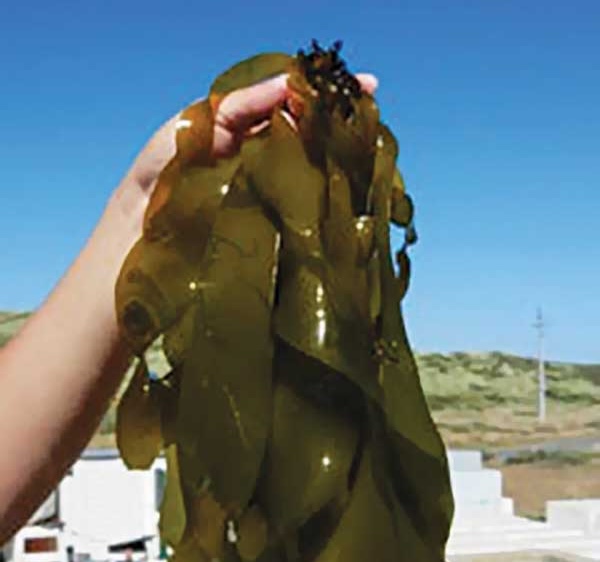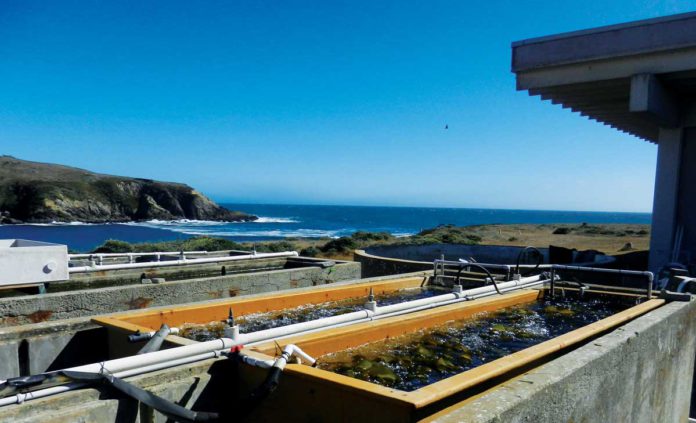On a sunny afternoon just north of Bodega Bay, two large troughs of water bubbled in the sunlight, toward the ocean. Swirling in the eddy of bubbles were slimy forest green blades of kelp. Julieta Gomez, the Greater Farallones Association (GFA) kelp restoration specialist, explained that these were blades of lab-grown bull kelp, a tall brown algae that towers dozens of feet over rocky coastlines like a tree.
Bull kelp forests were once a common sight along beaches all across Marin and Sonoma counties. But over the last decade, they have been almost entirely wiped out from the West Coast, only surviving in small pockets between Santa Barbara and Alaska. In Marin and Sonoma, their numbers have been wiped out by nearly 90%, replaced by vast areas of urchins, called urchin barrens. One such barren reaches hundreds of miles from Marin County, all the way to the Oregon border, according to work conducted by UC Davis researchers.
Since this loss was first noticed in 2014 by local urchin divers who have spent their lives and made their livelihoods in these underwater forests, a confluence of groups have attempted to bring back the kelp forests. From divers in Monterey attempting to kill the urchins, to a San Quentin prisoner-founded ocean stewardship nonprofit, SeaForester, many are attempting to help the kelp forests in any way they can.
And this summer sparks some serious hope for the future of kelp forests.
This July marks the first summer planting of lab-grown bull kelp along specific sites on the Sonoma coast by the Greater Farallones Association and NOAA. Starting in 2023, this project began to bring much needed action on returning a lost and biodiverse ecosystem back to our shores. The outplanting of kelp is occuring in Fort Ross Cove, Timber Cove, Ocean Cove and Stillwater Cove, with most of this year’s focus being in Fort Ross.
“I feel hopeful that we can get the forest to a point where it can become self-sustaining,” said Gomez. “It will probably take years, and it will take a lot of effort.”
The task for Gomez and the varying partners in this restoration project begins in the ocean.
In order to give the kelp a fighting chance at reestablishing itself in these forests, the sites that have been chosen must be cleared of urchins, specifically purple urchins.
Purple urchins, sometimes derogatorily called zombie urchins, can survive up to nearly a year without eating anything at all. This ability to fast for such a long time, along with their voracious appetite for kelp itself, has made the purple urchin the main reason for the decline of the kelp forests.
While people do eat urchins, the market is only for red urchins, a slower and less voracious eater of kelp than the purple urchins whose numbers have struggled to rebound with the loss of their kelp forest homes.
In place of swathes of swaying kelp blades with otters, seals, sunstars, red urchins and abalone, there are now vast rock beds covered almost exclusively in purple urchins, called urchin barrens. If a kelp starts to grow in these areas, one can be sure that it will be eaten before it has a proper chance to grow.
So, local urchin divers working with NOAA and GFA have been going out to specific sites, such as Fort Ross Cove, and picking out the purple urchins. They do this until a site is entirely cleared of the ravenous grazers. At this point, Gomez, with the help of other divers, heads into these areas and begins to plant the lab-grown kelp.
This bull kelp, originally brought over from Moss Landing Marine Lab, begins its life in outdoor tanks of circulating water, providing fresh oxygenated water to it. As the kelp matures, it will then begin to create small pockets of spores on its blades, called sporangia.
Gomez at the Bodega Marine Lab finds these floating lighter colored flecks and collects them, bringing them inside the lab to another smaller tank. These smaller tanks, equipped with bits of PVC pipe wrapped in twine, become the first home of the microscopic kelp, with many attaching to the small grooves of the twine until it is completely covered.


Once the miniscule kelp is firmly planted on the twine, around three or so months since the seedlings began to grow, this string is now ready to be taken out to the ocean to be outplanted. Gomez and a team of divers boat out to the coves, placing the PVC and twine onto a lead line which then slowly unspools. This releases the baby kelp, who will attach themselves onto the rocks and then grow out to the water’s surface. Thus begins their first moments in the ocean, and hopefully the return of kelp forests to Sonoma.
But how did we get to this point where kelp forests were nearly lost?
The first block in the chain to fall was the sea star, commonly known as the starfish. Many sea stars are vital predators to the rocky understories of kelp forests, eating mussels, snails and, most importantly, purple urchins, keeping at bay many of these kelp eating critters. However, in 2013, a large (and still mysterious to science) sea star wasting syndrome killed millions of sea stars along the West Coast, completely altering the ecological checks and balances of the kelp forests.
One such sea star that died quickly was the sunflower sea star. These animals, with two dozen legs and a growth as wide as three feet, were one of the main predators of purple urchins, along with sea otters. Once they died off, the purple urchins came in quickly, grazing down large stretches of kelp forests until there was little left for them to eat.
For the past decade, this has remained mostly unchanged, which is highly unusual.
Kelp forests, like many ecosystems, go through cycles of dying off and then returning, but usually only for a couple of years. With no sea otters living on the Sonoma and Marin coast and the sunflower sea stars still having yet to return to the coast in any significant numbers, the swathes of urchin barrens remain, with kelp forests now a memory. Those who remember their plenitude along the coast, mostly coastal residents and urchin divers who made their livelihood selling uni, have mourned the loss of these vast ecosystems.
“It was dramatic,” recounted Erik Owen, a long-time red urchin diver.
“I always figured the kelp would come and go in cycles,” Owen said. “I never in my wildest imagination would dream that we would have a purple urchin explosion that would take all the kelp away.”
Owen has been diving in the Sonoma waters since the ’70s, when his family moved to the area. In 1986, already working on salmon and crabbing boats as a deckhand and curious about urchin diving, he received a permit from the state and began to collect red urchins and sell them.
Since then, he has watched as places like Timber Cove have ebbed and flowed with kelp. Some years there were more kelp than others, more red and purple urchins than other seasons, but everything would always return in numbers. However, in 2014, after the purple urchins decimated the kelp forests, he returned to crabbing for his main source of income.
“I’ve watched the dynamic changes that the kelp forests have made from the red sea urchin fishery to the thriving recreational abalone fishery that was created after we pulled these red urchins out,” Owen said. “And then I watched it get dominated by purple urchins.”
Throughout the decades, he has seen the red urchins decrease in numbers, only to watch red abalone rebound in their absence. His deep and direct knowledge of these waters is vital to scientists and conservationists alike. As someone who has made his living in these forests, he does not want to see them disappear as they have.
However, noticing that kelp was faring better in Timber Cove, he thought he could maybe help the kelp along with its return.
“I just saw that there was an ability there to take these purple urchins out and to try to bring them back a little bit,” he explained.
So now Owen dedicates much of his work to removing purple urchins for GFA and NOAA sites. He and divers like him are taking to the ocean not to harvest uni, but to remove purple urchins, providing them with an opportunity to help return kelp forests back to the coast. This provides income for their labor in the process, as they can sell the purple urchins to NOAA.
While this project is only in its second year, the outlook for Owen is optimistic.
“I just think that it’s got hope,” Owen said. “And I hope that we can continue the project through the coming years and get it to the point where, in the long term, we can really sit down and look at what we’ve done and go, ‘Look at that. We made a difference.’”












So exciting! An Ocean restoration economy! Thanks for sharing!